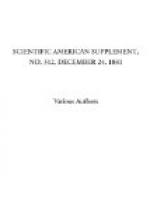The next matter I have to touch upon is
AGRICULTURAL MACHINERY.
In 1831, we had thrashing machines and double plows, and even multiple plows had been proposed, tried, and abandoned. Reaping machines had been experimented with and abandoned; sowing machines were in use, but not many of them; clod crushers and horse rakes were also in use; but as a fact plowing was done by horse power with a single furrow at a time, mowing and reaping were done by the scythe or the sickle, sheaves were bound by hand, hay was tedded by hand-rakes, while all materials and produce were moved about in carts and in wagons drawn by horses. At the present time we have multiple plows, making five or six furrows at a time, these and cultivators also, driven by steam, commonly from two engines on the head lands, the plow being in between, and worked by a rope from each engine, or if by one engine, a capstan on the other head land, with a return rope working the plow backward and forward; or by what is known as the roundabout system, where the engine is fixed and the rope carried round about the field; or else plows and cultivators are worked by ropes from two capstans placed on the two head lands, and driven by means of a quick-going rope, actuated by an engine, the position of which is not changed. And then we have reaping machines, driven at present by horses; but how long it will be before the energy residing in a battery, or that in a reservoir of compressed air, will supersede horse power to drive the reaping machine, I don’t know, but I don’t suppose it will be very long. The mowing and reaping machines not only cut the crop and distribute it in swaths, or, in the case of the reaping machine, in bundles, but now, in the instance of these latter machines, are competent to bind it into sheaves. In lieu of hand tedding, haymaking machines are employed, tossing the grass into the air, so as to thoroughly aerate it, taking advantage of every brief interval of fine weather; and seed and manure are distributed by machine with unfailing accuracy. The soil is drained by the aid of properly constructed plows for preparing the trenches; roots are steamed and sliced as food for cattle; and the thrashing machine no longer merely beats out the grain, but it screens it, separates it, and elevates the straw, so as to mechanically build it up into a stack. I do not know a better class of machine than the agricultural portable engine. Every part of it is perfectly proportioned and made; it is usually of the locomotive type, and the economy of fuel in its use is extremely great. I cannot help thinking that the improvement in this respect which has taken place in these engines, and the improvement of agricultural machinery generally, is very largely due to the Royal Agricultural Society, one of the most enterprising bodies in England.




